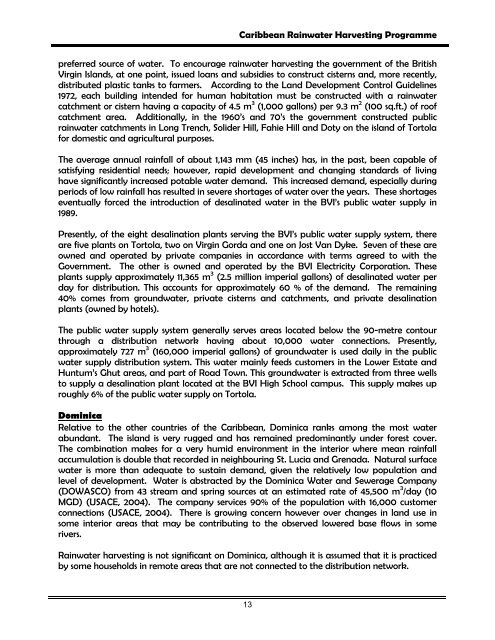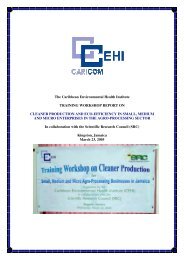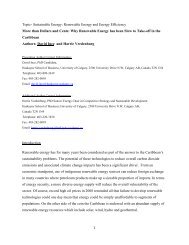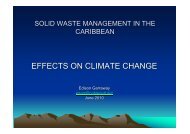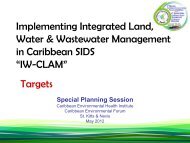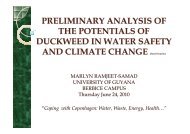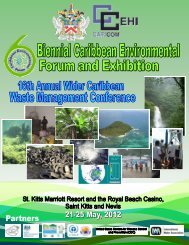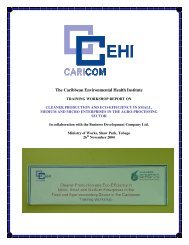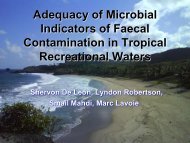A programme for Promoting Rainwater Harvesting in the Caribbean
A programme for Promoting Rainwater Harvesting in the Caribbean
A programme for Promoting Rainwater Harvesting in the Caribbean
Create successful ePaper yourself
Turn your PDF publications into a flip-book with our unique Google optimized e-Paper software.
<strong>Caribbean</strong> <strong>Ra<strong>in</strong>water</strong> <strong>Harvest<strong>in</strong>g</strong> Programmepreferred source of water. To encourage ra<strong>in</strong>water harvest<strong>in</strong>g <strong>the</strong> government of <strong>the</strong> BritishVirg<strong>in</strong> Islands, at one po<strong>in</strong>t, issued loans and subsidies to construct cisterns and, more recently,distributed plastic tanks to farmers. Accord<strong>in</strong>g to <strong>the</strong> Land Development Control Guidel<strong>in</strong>es1972, each build<strong>in</strong>g <strong>in</strong>tended <strong>for</strong> human habitation must be constructed with a ra<strong>in</strong>watercatchment or cistern hav<strong>in</strong>g a capacity of 4.5 m 3 (1,000 gallons) per 9.3 m 2 (100 sq.ft.) of roofcatchment area. Additionally, <strong>in</strong> <strong>the</strong> 1960’s and 70’s <strong>the</strong> government constructed publicra<strong>in</strong>water catchments <strong>in</strong> Long Trench, Solider Hill, Fahie Hill and Doty on <strong>the</strong> island of Tortola<strong>for</strong> domestic and agricultural purposes.The average annual ra<strong>in</strong>fall of about 1,143 mm (45 <strong>in</strong>ches) has, <strong>in</strong> <strong>the</strong> past, been capable ofsatisfy<strong>in</strong>g residential needs; however, rapid development and chang<strong>in</strong>g standards of liv<strong>in</strong>ghave significantly <strong>in</strong>creased potable water demand. This <strong>in</strong>creased demand, especially dur<strong>in</strong>gperiods of low ra<strong>in</strong>fall has resulted <strong>in</strong> severe shortages of water over <strong>the</strong> years. These shortageseventually <strong>for</strong>ced <strong>the</strong> <strong>in</strong>troduction of desal<strong>in</strong>ated water <strong>in</strong> <strong>the</strong> BVI’s public water supply <strong>in</strong>1989.Presently, of <strong>the</strong> eight desal<strong>in</strong>ation plants serv<strong>in</strong>g <strong>the</strong> BVI’s public water supply system, <strong>the</strong>reare five plants on Tortola, two on Virg<strong>in</strong> Gorda and one on Jost Van Dyke. Seven of <strong>the</strong>se areowned and operated by private companies <strong>in</strong> accordance with terms agreed to with <strong>the</strong>Government. The o<strong>the</strong>r is owned and operated by <strong>the</strong> BVI Electricity Corporation. Theseplants supply approximately 11,365 m 3 (2.5 million imperial gallons) of desal<strong>in</strong>ated water perday <strong>for</strong> distribution. This accounts <strong>for</strong> approximately 60 % of <strong>the</strong> demand. The rema<strong>in</strong><strong>in</strong>g40% comes from groundwater, private cisterns and catchments, and private desal<strong>in</strong>ationplants (owned by hotels).The public water supply system generally serves areas located below <strong>the</strong> 90-metre contourthrough a distribution network hav<strong>in</strong>g about 10,000 water connections. Presently,approximately 727 m 3 (160,000 imperial gallons) of groundwater is used daily <strong>in</strong> <strong>the</strong> publicwater supply distribution system. This water ma<strong>in</strong>ly feeds customers <strong>in</strong> <strong>the</strong> Lower Estate andHuntum’s Ghut areas, and part of Road Town. This groundwater is extracted from three wellsto supply a desal<strong>in</strong>ation plant located at <strong>the</strong> BVI High School campus. This supply makes uproughly 6% of <strong>the</strong> public water supply on Tortola.Dom<strong>in</strong>icaRelative to <strong>the</strong> o<strong>the</strong>r countries of <strong>the</strong> <strong>Caribbean</strong>, Dom<strong>in</strong>ica ranks among <strong>the</strong> most waterabundant. The island is very rugged and has rema<strong>in</strong>ed predom<strong>in</strong>antly under <strong>for</strong>est cover.The comb<strong>in</strong>ation makes <strong>for</strong> a very humid environment <strong>in</strong> <strong>the</strong> <strong>in</strong>terior where mean ra<strong>in</strong>fallaccumulation is double that recorded <strong>in</strong> neighbour<strong>in</strong>g St. Lucia and Grenada. Natural surfacewater is more than adequate to susta<strong>in</strong> demand, given <strong>the</strong> relatively low population andlevel of development. Water is abstracted by <strong>the</strong> Dom<strong>in</strong>ica Water and Sewerage Company(DOWASCO) from 43 stream and spr<strong>in</strong>g sources at an estimated rate of 45,500 m 3 /day (10MGD) (USACE, 2004). The company services 90% of <strong>the</strong> population with 16,000 customerconnections (USACE, 2004). There is grow<strong>in</strong>g concern however over changes <strong>in</strong> land use <strong>in</strong>some <strong>in</strong>terior areas that may be contribut<strong>in</strong>g to <strong>the</strong> observed lowered base flows <strong>in</strong> somerivers.<strong>Ra<strong>in</strong>water</strong> harvest<strong>in</strong>g is not significant on Dom<strong>in</strong>ica, although it is assumed that it is practicedby some households <strong>in</strong> remote areas that are not connected to <strong>the</strong> distribution network.13


